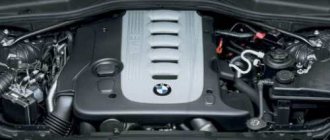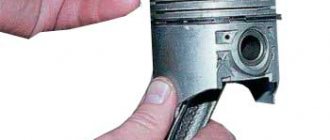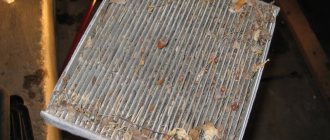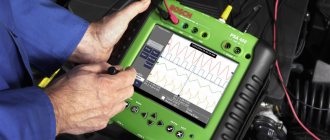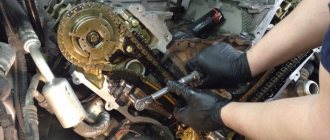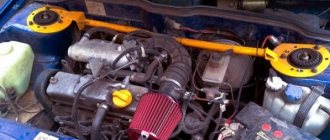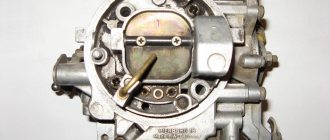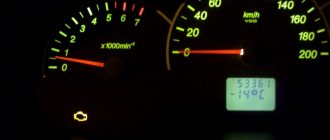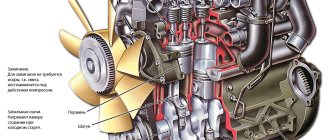A noticeable increase in vibrations or shaking, unstable operation of the internal combustion engine in various modes and the appearance of blue-black exhaust from a diesel engine may indicate that the diesel engine is oxidizing. The driver feels a strong vibration on the steering wheel, the engine reacts sluggishly to the gas pedal, does not develop power, and consumes a lot of fuel. This means that one or more cylinders are completely inactive. The second option is to operate the internal combustion engine intermittently.
We also recommend reading the article about why a diesel engine produces white exhaust. From this article you will learn about malfunctions that lead to the appearance of white smoke from the exhaust pipe of a diesel engine in different operating modes.
Diesel smokes white smoke and smokes
Most often, a diesel engine produces white smoke due to coolant entering the combustion chambers. The heated liquid flies out into the exhaust pipe. Sometimes its presence can be checked by holding your palm to the exhaust pipe - the wet deposit on it will have a characteristic sweetish odor characteristic of antifreeze. Liquid gets into the chambers most often due to a violation of the integrity of the cylinder head gasket. But the most unpleasant reasons for this will be warping of the cylinder head or cracks in it due to engine overheating. One of the signs of a burnt gasket or a crack in the cylinder head may be swollen (or simply become hard) radiator pipes, as well as a significant increase in the coolant level in the expansion tank. Usually, liquid mixed with steam begins to escape through the valve in the cap of the expansion tank or radiator. As a rule, the presence of coolant vapors in the exhaust gases is a signal that urgent “surgical intervention” is necessary - repair of the engine, or rather, its upper part. But the cause of white smoke from the exhaust pipe may be completely harmless - it is the evaporation of condensate accumulated in the exhaust system. The engine runs normally and the car does not stall at idle.
Lost compression in diesel engine
The crank mechanism in the engine must ensure synchronous movement of the pistons in the cylinders. Over time, during operation, parts of the cylinder-piston group (CPG) are subject to various wear, gaps and backlashes appear. This all reduces compression. Gas distribution valves wear out more often than pistons and cylinders, and gaps appear that do not provide the required compression.
Diesel fuel cannot heat up and spontaneously ignite if the degree of compression is insufficient. This is the reason why diesel engines have trouble starting. For high compression, the cylinders must be free of scoring and cavities. Pistons with rings should also be free of chips and the rings should not be stuck or bent. The valves must fit tightly into their seats; if there are cracks or chips, then, accordingly, the compression will not be maximum.
We recommend: What to do if the fan of the VAZ-2112 stove does not work
If the compression is not enough to heat and ignite the diesel fuel, then the diesel engine starts to burn when it is cold. When hot, a diesel engine runs much less, since the mating parts of the cylinder-piston group are expanded, which leads to the creation of increased compression (compression). This phenomenon, when a hot diesel engine calms down and shakes less, means that there are no serious breakdowns of the crank mechanism and timing valves.
Many drivers already buy themselves a pressure gauge to measure the compression pressure in the cylinders. It costs approximately 2,000 rubles at the beginning of 2022. Using this measuring device, you can easily understand what pressure is created (atmospheres or MPa (megapascal)). How much compression should be should be found out for each make and model of car individually.
The slight wear of the parts of the cylinder-piston group is compensated by the fact that when the engine is hot, the diesel fuel ignites much more easily; even with low compression, self-ignition occurs.
This phenomenon also occurs when a new cylinder head gasket (cylinder head) has just been installed. Usually, in this case, the behavior of the motor is that in a cold state the engine shakes a lot, and in a hot state it does not shake at all or adjusts. This is due to the fact that the new cylinder head gasket is thicker, so less compression is created.
Why is there not enough fuel in the cylinder?
Other problems with diesel engine stalling are associated with an insufficient level of the fuel mixture entering the engine cylinders. In this case, tripping also appears on a hot engine and is accompanied by abundant white smoke from the exhaust pipe. Its appearance is associated with the ingress of coolant into the combustion chambers.
The causes of tripping with such symptoms may be the following malfunctions:
- failure or clogging of injectors;
- malfunction of the high pressure fuel pump (HPF).
Diesel engine injectors supply fuel to the cylinder in a strictly prescribed dose according to a specific pattern. Clogging of the injectors is possible due to poor quality diesel fuel or untimely replacement of the fine filter. As a result, fuel is supplied unevenly to the engine cylinders and the engine begins to stall.
Also, tripping can be caused by a malfunction of the high pressure fuel pump (HPF). It is this unit that is responsible for supplying uniform doses of fuel at strictly defined moments. Wear of the fuel injection pump leads to insufficient pressure in the fuel system and a decrease in the intensity of fuel injection into the cylinders. The injection pump simply cannot push a sufficient dose of fuel through the injectors. As a result, the engine triples again.
We recommend: Which coolant is better to fill in Renault Logan: antifreeze or antifreeze?
Most often, the plunger pair in the fuel injection pump fails. Over time, its wear leads to the fact that the diesel engine stops starting altogether, since fuel stops flowing into the cylinders. At the same time, sometimes starting the engine from a pusher or hot is possible, but when starting from a standstill, the engine does not respond to turning the key. Also, fuel injection pump problems may be related to the fuel line, then the engine will trip constantly due to fuel leaks.
The third reason for the tripping associated with the fuel injection pump is associated with incorrectly configured fuel injection. On many car models, the fuel injection pump is equipped with a device that allows the engine speed to increase during a cold start, due to which the injection advances - fuel enters the still unheated engine. As the engine warms up, the speed decreases to standard values. Under load, on the contrary, there is a delay in injection for complete combustion of the fuel mixture.
As the injection pump wears out, this operating pattern is disrupted. The fuel injection advance angle no longer corresponds to the crankshaft speed. As a result, fuel stops getting into the cylinders in a timely manner and the diesel engine begins to stall. In this case, the effect can occur as the engine speed increases and the engine heats up, that is, when “cold” the engine works properly, but “when hot” it starts to malfunction.
What to do?
If you have the appropriate experience and have decided to independently eliminate the cause of the engine tripping, you first need to identify the source of the problem. Often the culprit of the malfunction in question is a defect or malfunction in the operation of the injectors. A critically worn nozzle, low pressure inside the injection elements, dirty channels, poor quality fuel - these are the main factors affecting the functionality of the injectors (see the article “How to check an injector nozzle”).
To fix the problem, you can clean the sprayer or replace it. It is recommended to update injectors on diesel power units every 120-150 thousand kilometers. A defective injector can be identified experimentally by moving it to another cylinder. If it also acts up, a malfunction has been detected.
If there is a cause of tripping caused by a faulty fuel injection pump, it may require repair or complete replacement. You can check this in practice using the same method as with the nozzle. If, after replacing the latter with a new part, the cylinder shows no signs of life, then the cause of the malfunction most likely lies in the high-pressure fuel pump.
A diesel engine may malfunction due to a malfunction of the valve mechanism of the problem cylinder. Typically this problem is accompanied by valve knocking. First of all, it is necessary to check the gaps between the elements and, if necessary, adjust them. Violation of the distances between the valves contributes to the fact that the diesel engine only stalls when the engine is hot. With such a malfunction, sufficient compression will not be created in the engine.
Spark plugs with soot affect the appearance of the problem in question, most often in cold weather when the engine is not warmed up. They should be replaced in a timely manner. The faults discussed are the main reasons why a diesel engine stalls. For timely treatment of the “heart” of the car, it is necessary to take immediate action by contacting a service station or on your own, if you have experience and confidence in a positive result.
The engine runs rough both on gas and at idle speeds
Interruptions in engine operation in all modes indicate either problems in the power system or irregular valve timing. But, however, there may be more serious problems - such as burnout of the piston crown or breakdown of timing parts (for example, breakage of valve springs or burnout of a valve).
Interruptions in engine operation in all modes indicate either problems in the power system or irregular valve timing. Typical malfunctions of the power system include clogging of injectors, fuel filters, air leaks and are determined during complex diagnostics https://diesel-remont78.ru.
Even cleaning the injectors of a modern diesel engine requires quite expensive equipment, let alone repairing the injection pump... Therefore, if the diesel engine is running “hot” at idle, it is best to contact a qualified specialist. Self-repair can lead to unjustified expenses - if you randomly replace parts, then diagnostics and repairs will cost a pretty penny. Sometimes, even for a specialist, it’s a mystery “why does a diesel engine stall?” becomes a tough nut to crack - modern fuel equipment cannot be diagnosed by eye, and the abundance of electronics does not make the task easier. If old diesel engines could operate practically under water (provided that it did not enter the intake tract), then a modern engine can simply stall in wet weather.
We recommend: The dashboard of the domestic “Seven” and its features
How to determine the malfunction yourself?
To identify the reason why the motor is tripping on its own, you must adhere to certain rules. First of all, you should evaluate the sound of the engine and its functions while driving. If any changes and vibration noises are noticeable, this may well be a sign that the power unit is malfunctioning.
On a warm car, characteristic sounds indicate the malfunction in question. At idle, uneven engine operation with twitching is also a sign of a malfunction of one of the cylinders. Particular attention should be paid to spark plugs and high-voltage wires. If you have any doubts that the motor is malfunctioning, it is better to contact a specialist, since delaying diagnostics and repairs can lead to serious damage.
Early or late fuel injection
For proper operation of a diesel engine, it is necessary to set the fuel injection mode at which it will be optimal (fuel supply will be timely).
If a diesel engine operates in an early fuel injection mode, that is, ahead of the cycle, then the power of the internal combustion engine increases, but accelerated wear of engine parts occurs. Therefore, the advance angle and the desired engine output must be balanced.
High-pressure fuel pumps themselves are able to regulate the supply time, namely, the injection pump is able to raise the diesel speed when it is cold, that is, it creates an early fuel injection mode. Then, when the diesel engine warms up, the idle speed is reduced to optimal. The fuel supply advance also becomes normal, average for power and wear of internal combustion engine parts.
During engine load, there must be late injection so that the supplied fuel is completely burned. The design also provides for automatic advance adjustment by changing the pressure of the supplied fuel by a high-pressure pump. The regulator, which changes the injection timing independently, is mounted in the fuel pump.
A worn injection pump results in the injection advance angle not matching the crankshaft speed. Because of this, the motor triples.
Other reasons that influence changes in the injection advance angle:
- the fuel injection pump drive is worn out;
- pressure reducing valve is worn out;
- The return filter is clogged.
If the diesel engine does not start when cold and at idle, but when you press the gas pedal and increase the crankshaft speed, it begins to adjust, then the fuel injection advance angle is either late or early.
Constant monitoring of the diesel power system, fuel injection pump and maintenance will increase the service life of the engine.
Diesel trouble due to fuel supply
There are two reasons associated with the supply of fuel to a diesel internal combustion engine:
- Insufficient fuel supply pressure from the fuel pump.
- Fuel injection is provided in a small volume.
For these reasons, the engine efficiency is low, diesel fuel is not sprayed in the working combustion chamber and combustion of the mixture does not occur completely.
It may be that the high pressure fuel pump supplies diesel fuel at the required pressure, but the injectors supply different volumes to the cylinders. The ignition time for different volumes of fuel supply is different, so the diesel engine begins to shake.
If a portion of fuel does not flow through the injector at all for one cycle, then the diesel engine begins to stall.
After cleaning, repairing or replacing the injectors with new ones, you must also adjust the injectors before installation.
When carrying out repair work on the injectors, the fuel injection pump should be adjusted. Since the pump may be worn out or its operating modes may be incorrectly configured, it may supply diesel fuel with low pressure. If you replace only the injectors, without checking and adjusting the fuel injection pump, the diesel engine will detonate and run rough. Therefore, when working on injectors, the high-pressure fuel pump must also be checked. Diesel engine detonation will lead to major repairs. Detonation means the ignition of a flammable mixture is accompanied by an explosion, a shock wave.
